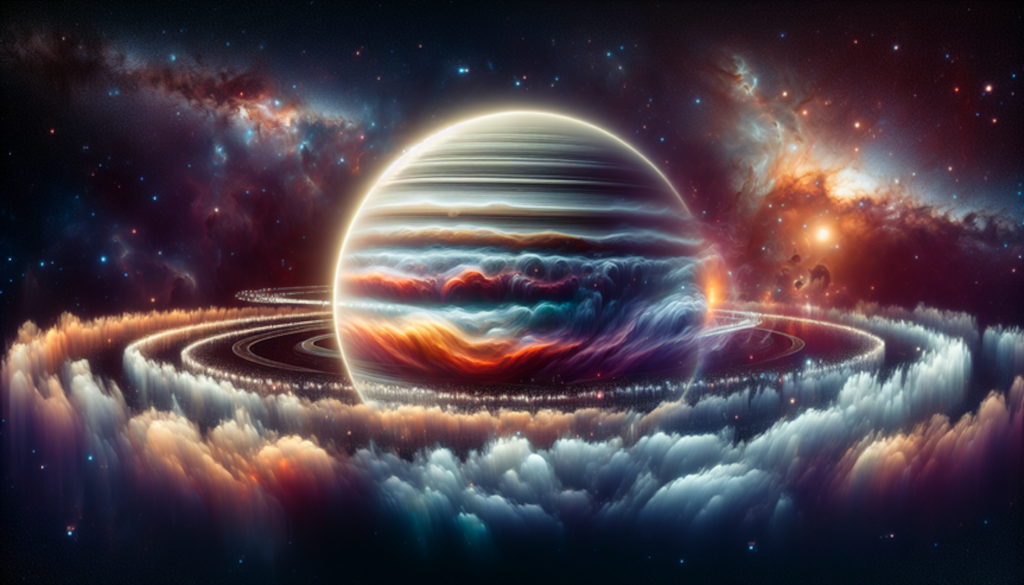Here’s something mind-bending: Jupiter is over 300 times more massive than Earth, yet unlike a rocky planet, it doesn’t have a solid surface. So why doesn’t it look like a free-floating gas cloud, loosely swirling around a tiny core like a cosmic cotton ball?
If you’ve ever wondered why gas giants like Jupiter and Saturn stay together as spherical “balls” instead of drifting off as giant space nebulae, you’re not alone. I used to picture them as loose clouds with dense centers—majestic but unstable. But the truth is far cooler (and a lot more powerful).
The surprising power holding a gas giant together
The answer is deceptively simple: gravity.
But not just any gravity—the kind that acts equally in all directions and increases explosively as you pile on mass. Once a forming planet reaches a certain size (usually around ten times the mass of Earth), its gravity becomes intense enough to trap staggering amounts of gas. From that point on, something extraordinary happens.
- No more leaking gas: A dense enough core pulls gas inward faster than it can escape, ending the era of chaotic drifting.
- Sphere formation kicks in: Gravity naturally pulls everything toward the center, and the most stable shape for that? A sphere. It’s like wrapping the planet in a giant invisible hand, squeezing it into the most energy-efficient shape possible.
Inside a gas giant: what you’ll find (hint: it’s not all gas)
Here’s where things get even weirder—in the best way possible. As you dive deeper into a gas giant, the pressure gets so extreme that the hydrogen gas starts acting like a liquid. Go even deeper? That hydrogen becomes metallic. Yes, metallic hydrogen—a state of matter we can’t easily recreate on Earth, though experiments like those at the National Ignition Facility have tried.
Jupiter and Saturn are basically floating pressure cookers. At their hearts are rocky and icy cores, likely similar to Earth in size, wrapped in thousands of kilometers of compressed hydrogen and helium. Far from being shapeless or diffuse, these layers are immensely ordered, stacked like a planetary parfait.
But what about nebulae? Why don’t they do the same thing?
Now let’s flip the script. A nebula is basically the opposite of a gas giant—it’s a huge, diffuse cloud of gas and dust that hasn’t collapsed into a ball. Why? It lacks the gravitational muscle to pull itself inward. Without a core of critical mass at its center, there’s no “anchor” to tighten the gas and dust into a firm structure. It remains spread out, vulnerable to being shaped by nearby stars, shock waves, or even friendly fly-by planets.
Real-world clues: what we’ve seen
In 1995, the Galileo Probe dove into Jupiter’s atmosphere, measuring temperature, pressure, and composition directly. It hit increasingly dense gas and was crushed before ever reaching a core. This proved what models had predicted: Jupiter isn’t just a big cloud. It’s a layered monster with crushing forces—and neat organization.
More recently, NASA’s Juno Mission has been mapping Jupiter’s gravity field, revealing that it isn’t uniform. These subtle variations tell us layers inside the planet behave like a fluid—but in a structured, not chaotic, way.
The cosmic truth: gravity builds order from chaos
So the next time you look up at Jupiter shimmering in the night sky, remember: its majestic, spherical appearance is no accident. It’s the result of gravity’s relentless pull and gas collapsing under unimaginable pressure. It may seem like a balloon, but it’s more like a pressurized steel vault—exotic, dense, and anything but soft.
Here’s your takeaway: A gas giant isn’t a floating gas cloud. It’s a highly structured pressure system forged by immense gravity. And unlike a nebula, it turns chaos into order, layer by powerful layer.
So simple question, complex answer—and ultimately, one that gives gas giants their shape, their beauty, and their story.




Leave a Comment